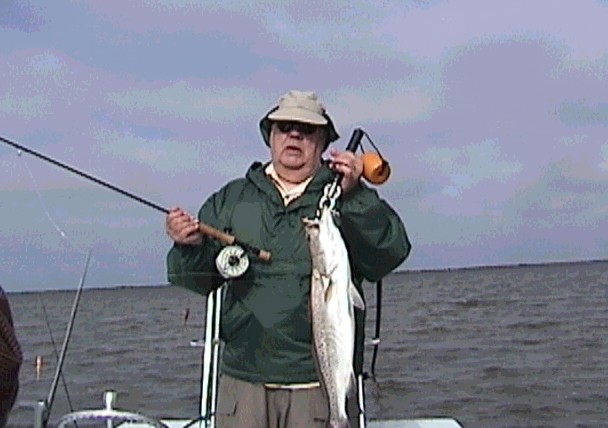Here's a bit from my word document/references on fish and color eyesight as well as night vision. In addition to this I've read, studied and have experienced other aspects of using a surface lure, bug or fly. My conclusion are that fish are, like all of us, habitual creatures. This point was driven home when fishing years ago at Clear Lake, near Spokane. The USAF resort there had great numbers of yellow jackets frequenting the empty soda cans and trash barrels. A fwe were straying down to the lake side and I noticed that they were getting, for lack of a better term, "SMACKED!!" I started watching, grabed my flyrod, put some fly on and was getting sipping bites from gills and smallish bass but not the "SMACKS!!" I dug around in a trout box, found a McGinty, put it on and, yep, "SMACK!!" They would take the fly with a vicious hit, dragging it down and trying to tear it apart. I'ts conjecture on my part but my bet is that this was a habit formed from a sting or two. Yellow and Black spell wasp, Bumble Bee or Yellow Jacket/Hornet to a fish and they hit these flys with a vengance.
Years of almost daily and nightly SCUBA diving also drives home the point of color as many fish who are brightly colored during the day, when other fish can see them, turn almost pale at night, or dark, blending in with their environment whether nooks and crannies or on the sand. Therefore it's my studied opinion that colors, contrast, and more play a huge part when tying flies as does mimicing the behavior of the "hatch," be it minnow, crayfish, bug, beetle, fly, wasp or spider. Each behaves in a certain fashion when the hit the surface or even subsurface and the most successful angler will be able to mimic this behavior with their fly.
Do fish see in color?
"There is not just a single answer to this question since not all fish have been tested for color vision. However, the common goldfish certainly sees in color and many more at least have the necessary nervous system elements for color vision to be present. Color vision is the capability to see and recognize objects based not on how bright they are, but on how well they absorb, reflect or transmit light of different colors. For example, an apple looks red in sunlight because all but the red part of the white light from the sun falling on it is absorbed by the apple's skin leaving only the red light available for vision.
In order to have color vision, the retina in the back of the eye must have color detectors, called cones, present and the brain has to be wired to make use of the information it gets from the cones. We have three different kinds of cones in our eyes, called red, green and blue that make human color vision possible. The goldfish has four kinds of cones: red, green, blue and ultraviolet. Other fish have different numbers and kinds of cones meaning that they have the capability of seeing in color. However, simply finding cones in the eye does not mean that an animal has color vision. You have to test it behaviorally to see if it can tell one color from another. For example, I could set up a tank with two windows at one end whose color I could change. I would start by making one window gray, that is having no color, and the other red. Whenever the fish went to the red window I would give it some food. I would change the brightness of the gray and red windows to make sure that the fish was training to only color. As soon as the fish had learned to associate red with food, I would start to replace the gray with other colors and see if the fish still only went to the red. This would be repeated for lots of different color combinations. If the fish remained true to its trained color, than it would be said to have color vision. To date, this kind of testing has only been done for a few kinds of fish. However, I am confident that as we test many more kinds of fish we will find color vision to be very common."
Ellis R. Loew
Professor of Physiology
Biomedical Studies, Cornell University
Education
Ph.D. UCLA
Research Area
Vision
"Walleye have two very large eyes, from which this fish aptly derives its' name. The walleye can see many colors, but is color blind to some. The walleye has a light reflecting membrane called a ?Tapetum lucidum', this special feature helps the walleye see very capably at night, and during low light conditions."
Snook - ECKELBARGER, K.J.; SCALAN, R.; NICOL, A.C. 1980
The outer retina and tapetum lucidum of the snook
Centropomus undecimalis (Teleostei). Can.J. Zool.,
Toronto, 58: 1042-1051.
Similar scientific on Channel Catfish and other fish!
Sea Trout - "Seatrout also have an appendage in their eyes called a tapetum lucidum, which allows them to see better in low light conditions. It gives them a big advantage over baitfish that lack the feature, and is why large trout feed best at dawn, dusk and on rainy days." http://sports.espn.go.com/outdoors/f...ory?id=2718835
Great summation article: http://www.midcurrent.com/articles/s...oss_color.aspx
"The majority of fish have developed eyes that will detect the type of colors typical of their environment. For example, inshore fish have good color vision, whereas offshore pelagic fish have limited color vision and detect only a few if any colors other than black and white. This is not surprising from an evolutionary point of view, because nearshore waters are lit with many colors; offshore waters, on the other hand, are mainly blue or green and contain few other colors.?\"
__________________
Good Fishing,
Chuck S (der Aulte Jaeger)
"I've traveled a long way and some of the roads weren't paved"
Subscribe to:
Post Comments (Atom)


No comments:
Post a Comment